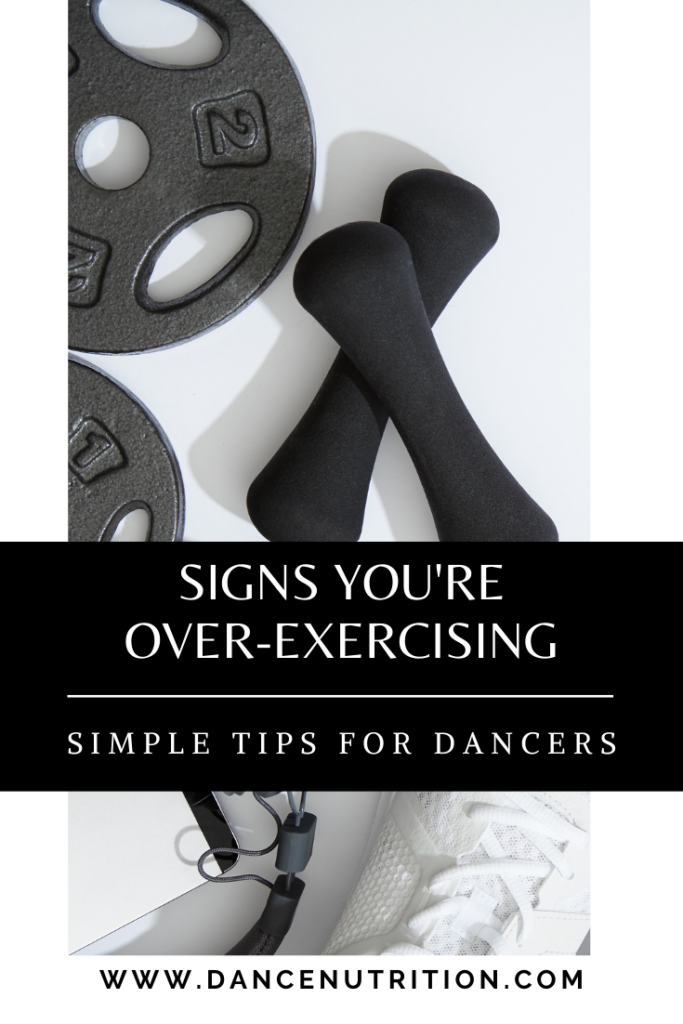Late into my dance training, I recognized the importance of cross-training. After a few Google searches, I built a workout regimen to strengthen my infrastructure. But thanks to my Type A personality, harmless advice soon turned obsessive. What started as a few minutes of stretching spiraled into a time-consuming routine with little room for error. The guilt of missing a day was overwhelming. It was mentally easier for me to push through this demanding workout schedule than to deal with the anxiety of NOT completing it.
Alongside this was a disordered relationship with food. My cross-training went from enhancing my dance technique to being a form of punishment for eating. I had to “burn off” everything and “earn” less-healthy foods. In a few short months, I burnt out, developed an injury, resented ballet, and ultimately, lost the passion I once had for the art.
My disordered eating was coupled with a growing obsession with exercise.
What does it mean to over-exercise?
Dancers have exercise built into their lifestyles. Whether it’s classes, rehearsals, or cross-training, hitting the minimum requirement for daily activity isn’t the issue— it’s knowing how much is too much.
Overexercise, or overtraining, occurs when the body is subjected to more physical stress than it can recover from. What might happen next?
- Injury from the continuous strain on muscles and joints— stress fractures, tendonitis, and muscle tears.
- Persistent fatigue and tiredness that doesn’t improve with rest.
- Mental health declines like burnout, anxiety, and stress.
- A weakened immune system makes dancers more susceptible to illnesses.
Signs A Dancer Is Over-Exercising
While cross-training is essential to enhance strength, flexibility, and endurance, it’s crucial to recognize when your cross-training efforts become excessive.
- You’re chronically tired, even after resting.
- You’re always getting sick.
- You’re having trouble falling asleep or staying asleep.
- You’re frequently injured or noticing prolonged recovery times.
- You’re experiencing a significant increase or decrease in appetite.
- Your muscle soreness doesn’t seem to quit.
- You’re moody, irritable, and anxious.
- You feel resentment towards the very movement that once made you happy.
- You haven’t gotten your period in a while.
It’s hard to associate signs like fatigue and muscle soreness with over-exercise. Performance seasons are always demanding. Hours of classes and rehearsals are coupled with late-night shows. And while the impact of a missing menstrual cycle is nothing to take lightly, I want dancers to focus on the possibility of resentment.
To turn against your passion in the name of over-exercising and under-eating. Is it really worth it?
How Much Cross-Training is Too Much?
Finding the right balance in cross-training is key and takes exploration. Start noticing how your body feels during and after workouts. Ask yourself: can I keep up with this cross-training schedule without burnout? Is missing a day of exercise making me feel anxious?
If you answered “yes” to any of these questions or you’re experiencing persistent soreness or fatigue, it may be time to scale back.
Strategies for Supportive Cross-Training
#1: Stay Fueled
A calorie deficit, whether intentional (you’re not eating enough to support the amount you’re burning) or unintentional (you’re not eating enough because of a busy schedule) risks your metabolism and sacrifices your bone health. Eating enough to support your body’s metabolic AND physical needs is key. Here’s an article to help identify whether or not you’re eating enough.
#2: Support Your Relationship with Food
Eating too little makes you feel irritable, drained, and tired. If you’re avoiding your favorite foods, you’ll feel unsatisfied and likely to fall into behaviors like grazing and overeating. Skip the restrictive mindset. Instead of rules, make food choices that support your physical, mental, and emotional well-being. Read this article to learn more about how to do this.
#3: Make Time For Joyful Rest
Ignoring your body’s signals for needing rest can spiral into burnout. Ensure you have at least one full rest day per week. Rest days are crucial for muscle recovery and overall well-being.
Taking a break can help you feel stronger physically and artistically. But first, you might need to re-learn the signals when your body needs rest. Fun fact: this is similar to when we’re re-learning our hunger and fullness cues. Next time you’re having a day when your intuition asks for rest, what clues is it giving you? Any particular pain or fatigue? Or is it just an overall feeling of “sorry, not today”? Take note of those signals- jot them down. This will help you become even more attuned when you need rest. Click here to learn more about joyful rest for preventing burnout.
#4: Make Movement Less Prescriptive
Focus on a routine that feels less rigid. Alternate between high-intensity and low-intensity cross-training sessions— from yoga and pilates to foam rolling and gentle walks, all can support your efforts. Socializing can make cross-training more enjoyable and motivating. Click here to learn more about the different types of cross-training.
You’ll also need to consider your dance schedule when planning cross-training activities. Avoid heavy cross-training sessions on days when you have intense dance rehearsals or performances.
#5: Rely on Dance Fitness Pros
Google doesn’t know your body. You’re the expert. However, learning appropriate exercises to support your strength and endurance is important to avoiding injury and overuse. Focus on the quality of your cross-training exercises rather than the duration. Proper form and technique are more important than the length of the workout. Professional educators are available to enhance your training sustainably. Here are a few of my favorites:




